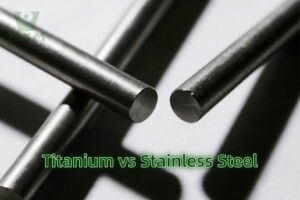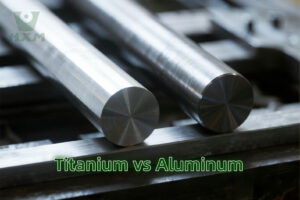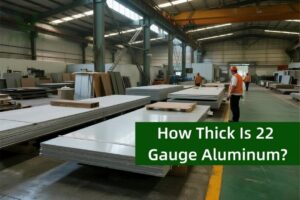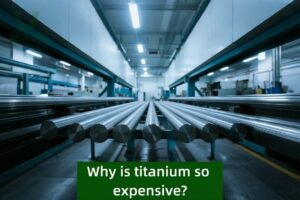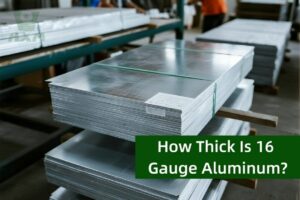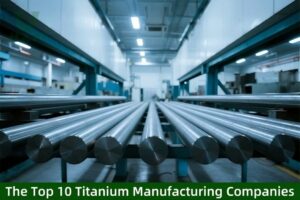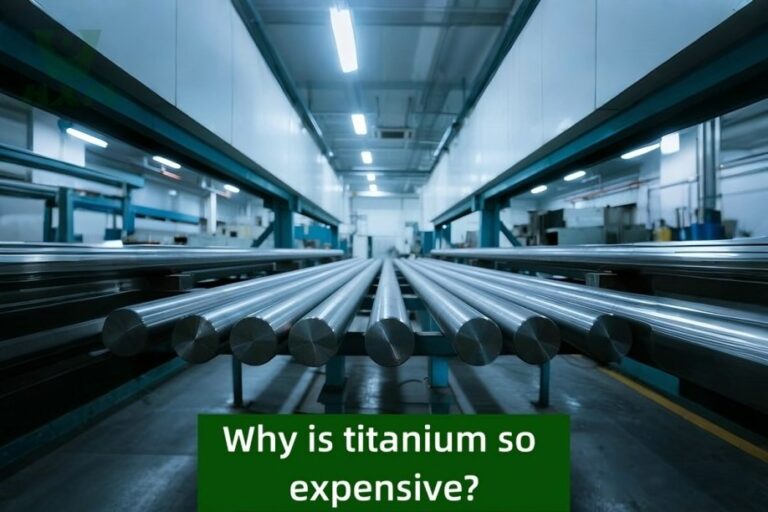
Titanium. The name itself evokes strength, lightness, and cutting-edge technology – from jet engines and deep-sea submersibles to top-tier medical implants and premium jewelry (titanium grade earrings). Yet, this remarkable metal titanium carries a significant price tag, often many times higher than common structural metals like steel or aluminum. As Huaxiao-Alloy, a leading global supplier of high-performance titanium metal plate and alloys, we understand the complexities behind this cost. Let’s dissect the key reasons why titanium is so expensive.
1. The Costly Extraction & Refinement Process (The Kroll Process)
Unlike iron ore which can be dumped directly into a blast furnace, extracting titanium metal (ti metal) from its raw ore minerals (primarily Ilmenite and Rutile – forms of titanium chemicals) is notoriously complex and energy-intensive. The dominant method for nearly 80 years is the Kroll process:
- Step 1: Chlorination: Ore is converted to Titanium Tetrachloride (TiCl4, a highly corrosive ti chemical liquid).
- Step 2: Purification: TiCl4 is distilled to extreme purity – essential for strong, corrosion-resistant metal.
- Step 3: Reduction: Pure TiCl4 is reduced using molten Magnesium (Mg) in an inert argon atmosphere. This requires massive, sealed reactors operating at high temperatures (up to 1000°C / 1830°F) for days.
- Step 4: Sponge Removal & Processing: The product is porous “Titanium Sponge” (raw titanium metal) mixed with Magnesium Chloride (MgCl2). The MgCl2 is removed by acid leaching and/or vacuum distillation. The sponge is then crushed, blended to ensure uniformity, and pressed into electrodes.
- Energy & Labor Intensity: Every stage consumes vast amounts of energy (especially the high-temperature reduction step). Handling corrosive gases and liquids necessitates expensive corrosion-resistant equipment and stringent safety protocols. The process is largely batch-based, limiting throughput.
Why hasn’t a cheaper process replaced Kroll? Decades of research haven’t yielded a fundamentally cheaper, scalable industrial alternative. This remains the single biggest cost driver for titanium the metal.

Titanium Alloy Strip / Precision Strip
Huaxiao-Alloy supplies medical & aerospace-grade Titanium Alloy Strips (0.05–5.0 mm) with ±0.005 mm tolerance. AS9100D & ISO 13485 certified. Custom slitting, annealing, global delivery. Request samples!
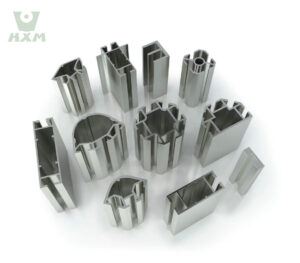
Huaxiao-Alloy manufactures high-performance Titanium Alloy Profiles (ASTM B381/ASME SB381) for aerospace, medical, and energy sectors. AS9100D & ISO 13485 certified. Custom sizes, global delivery, competitive MOQ. Request samples now!
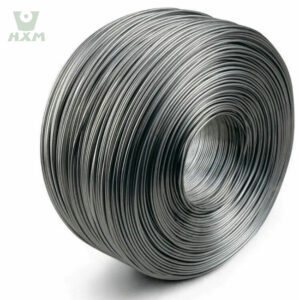
Huaxiao-Alloy supplies premium titanium wire and mesh for aerospace, medical, marine, and chemical industries. ASTM/AMS-certified, corrosion-resistant solutions with high-temperature stability. Request a quote today!
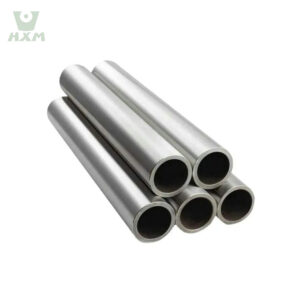
Huaxiao-Alloy – Premium titanium alloy pipe & tube manufacturer. ASTM/AMS-certified solutions for aerospace, medical, and chemical industries. Request a quote!
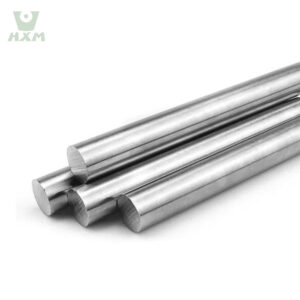
ISO 9001 certified titanium bar manufacturer supplies Grade 5/23/7 round/flat/square bars. Get AMS 4928 compliant 6Al-4V bars with full traceability. Request quote!
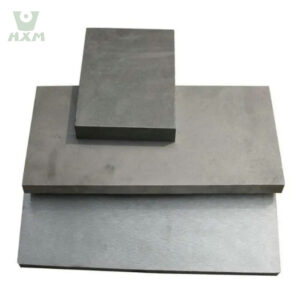
Huaxiao Alloy supplies premium titanium plates, sheets & coils (1/4”, 1/8”, 5mm) for aerospace, armor, and industrial use. TC4, Gr5, and custom alloys available. Free quote & global shipping!
2. Vacuum Arc Remelting (VAR) - Doubling Down on Purity
For most critical aerospace and medical applications (what is titanium metal used for), Titanium Sponge isn’t pure or consistent enough. It undergoes Vacuum Arc Remelting (VAR):
- Sponge is compacted and welded into electrodes.
- Electrodes are melted under vacuum in a water-cooled copper crucible using a powerful electric arc. This high-purity melt solidifies into a “ingot”.
- Benefits: Removes dissolved gases (oxygen, nitrogen), volatile impurities (like residual Magnesium), and homogeneously distributes alloying elements. Improves fatigue strength and fracture toughness significantly.
- Cost Factor: VAR is incredibly energy-intensive. Melting under vacuum requires specialized, expensive equipment. The process is slow and adds another layer of cost, essential for pure titanium metal grades and critical alloys. Some alloys even require double (D-VAR) or triple melting (VAR + ESR).
3. The Difficult Machining & Fabrication Challenge
Even in its relatively pure forms, titanium (ti element) earns its nickname as a “gummy” metal:
- Low Thermal Conductivity: Heat generated during cutting doesn’t dissipate easily. It concentrates at the tool tip, drastically shortening tool life. Specialized tool geometries and rigid setups are essential.
- High Chemical Reactivity at High Temp: Titanium reacts with cutting tool materials (like Carbide, CBN, Diamond) at cutting temperatures, accelerating wear. High-pressure coolant is often mandatory.
- Low Modulus of Elasticity: Titanium deflects more than steel under cutting pressure, requiring careful fixturing to prevent chatter and maintain precision (titanium models, tight-tolerance parts).
- Work Hardening: Easily occurs if machining parameters aren’t perfectly optimized, requiring frequent tool changes.
- Result: Slow machining speeds, frequent tool replacements, specialized equipment/coolants, skilled operators, and significant material waste (sometimes 80-90% for complex forgings). This significantly adds to the cost of finished titanium sockets, titanium ball bearings, or titanium legs/implants compared to making the same part from steel.
4. High Processing Costs Beyond Machining
- Forming: Requires higher pressures than steel due to its strength. Hot forming is often necessary, adding energy cost and complexity.
- Welding: Requires extremely inert shielding gases (high-purity Argon or Helium mixtures) and often sophisticated techniques (like EB, Laser, or GTAW in inert chambers) to prevent atmospheric contamination that embrittles the weld. Skilled welders are essential.
- Heat Treatment: Used to achieve specific microstructures and properties (grade 9 titanium vs. CP grades vs. Ti-6Al-4V), adding process cost. Cleanliness is paramount to prevent surface contamination (“alpha case”).
5. Relative Abundance vs. Usability
- Not Rare, But Accessible Ore…: Titanium (chemical element titanium, Ti, atomic symbol 22, titanium element**) is the 9th most abundant element in the Earth’s crust – far more common than copper or zinc. Why the high price?.
- …But Bound Tightly: Titanium is chemically very reactive and always bonded to oxygen or other elements in nature. Extracting pure metal, as outlined above, is extremely difficult and costly. Its abundance doesn’t translate into cheap metal. Is titanium worth anything? Absolutely, but extracting and processing it commands a high price.
Titanium Grades & Relative Price Comparison
| Grade | Common Name | Primary Components | Key Properties | Relative Cost Est. (vs. CP Gr1) | Common Applications |
|---|---|---|---|---|---|
| Gr 1 | CP (Commercially Pure) Ti | >99.5% Ti | Best formability, ductility, corrosion res. | Base Cost (100%) | Chemical processing, marine, jewelry (titanium grade earrings) |
| Gr 2 | CP Ti | >99.2% Ti, slightly more O | Slightly stronger than Gr1, excellent corr. res. | ~105-110% | Heat exchangers, architectural, marine |
| Gr 4 | CP Ti | >98.9% Ti, higher O | Highest strength CP Grade | ~120-130% | Cryogenic vessels, aerospace cold structures |
| Gr 5 (Ti-6Al-4V) | Titanium Alloy | Ti, 6% Al, 4% V | Workhorse aerospace alloy. Excellent strength-to-weight | ~200-250%+ | Jet engines, airframes, medical implants (titanium legs), titanium ball |
| Gr 9 (Ti-3Al-2.5V) | Titanium Alloy | Ti, 3% Al, 2.5% V | Good strength, excellent weldability, formability | ~150-180% | Hydraulic tubing (aircraft), bicycle frames, sporting goods |
| Gr 7 (Ti-Pd) | CP Ti + Pd | Ti, 0.12-0.25% Pd | Enhanced crevice corrosion resistance | ~300-400%+ | Chemical process industry (severe conditions) |
| Gr 23 (Ti-6Al-4V ELI) | Ti Alloy | Ti, 6% Al, 4% V (Low Int.) | Higher purity Gr5 for improved fracture toughness | ~250-300%+ | Critical medical implants, aerospace forgings |
*(Note: CP = Commercially Pure; Actual titanium price chart fluctuates significantly with market demand, energy costs, and sponge production volumes; CP Gr2 is often the most common general-purpose sheet/plate; Titanium costs are always significantly higher than carbon/aluminized steel.)*
Titanium Price Comparisons at a Glance
- Titanium vs Steel Price: High-strength titanium steel (like Grade 5 Ti-6Al-4V alloy) can cost 10-30x more per pound/kilo than standard structural steel plate. Even CP Titanium (ti metal) is typically 5-10x the cost. This cost of titanium vs steel is primarily due to processing, not raw material.
- Titanium Cost vs Gold: Titanium is substantially cheaper than gold. While prices fluctuate, titanium sponge is typically 5−10/lb, mill products 15−100+/lb. Gold trades around ~$24,000/lb! Is titanium more expensive than gold? Absolutely not. Is titanium worth more than gold? By weight, no. Titanium cost vs gold reveals gold is vastly more expensive. Gold’s value is primarily financial/store of value, while titanium’s value is functional.
- Highest Valued Metal?: While incredibly expensive due to rarity and nuclear applications, Californium-252 holds the title for the world’s most expensive metal commercially traded (millions per gram). Titanium’s value lies in its unique properties, not extreme rarity. How much is titanium worth today? Check market sources (titanium metal price) for current mill product spot prices.
Huaxiao-Alloy: Your Strategic Partner for Cost-Effective Titanium Solutions
While titanium (titanium, titanio, titânio, titanuim, taitaniam, titanum, titenium, tiatanium, titaniom, titaniun) is inherently costly, Huaxiao-Alloy leverages expertise, efficient processing, and supply chain relationships to provide exceptional value:
- Deep Technical Knowledge: We guide you in selecting the most cost-effective grade (CP Gr1, Gr2, Gr5, Gr9) for your application. Do you need aerospace purity or standard corrosion resistance? We match properties to requirements.
- Specialized Stock: We maintain ready inventory of common mill forms (titanium sheet stock, plate, bar, tube) in popular grades and sizes, minimizing costly custom mill orders.
- Precision Processing: Our machining and fabrication expertise minimizes waste (titanium metal for sale) and optimizes yield from expensive raw material, lowering your finished part cost.
- Supply Chain Efficiency: As a major supplier (titanium industries), we secure competitive pricing on sponge, intermediate forms, and mill products, passing savings on to you.
- Quality & Traceability: Guaranteed conformance to AMS, ASTM, MIL, and ISO specs. Know your pure titanium metal grade and origin.
- Innovation Support: From concept to finished product, we help navigate the complexities of working with this essential ti chemical element.
A: Primarily due to the extremely complex, energy-intensive, and multi-step Kroll process needed to extract pure metal from ore, coupled with expensive melting techniques (VAR/VAR) and difficult machining. The titanium vs steel price difference reflects these processing costs.
A: No. By weight, titanium is vastly cheaper than gold. Gold is primarily valued as a precious metal/store of wealth. Titanium’s value lies in its unique engineering properties. Gram-for-gram, gold is orders of magnitude more expensive (is titanium worth anything – yes, just less than gold per weight).
A: Production costs (energy, magnesium, labor), demand (especially aerospace cycles), alloy grade (grade 9 titanium vs CP vs Ti-6Al-4V Gr5), form (sponge, ingot, mill product), and quantity. Prices vary widely – contact us for current titanium sheet metal price or specific mill product quotes.
A: Titanium (titanium the element, ti element**) is the 9th most abundant element in the Earth’s crust, not rare at all! The high cost comes entirely from the difficulty and expense of extracting pure metal from common ores like Rutile.
A: Titanium forms strong bonds with oxygen, nitrogen, and carbon. Extracting pure metal requires breaking these bonds without allowing re-contamination, necessitating complex steps like chlorination and magnesium reduction under inert gas (Kroll process) and vacuum melting (VAR).
A: No! Complex alloys (Ti-6Al-4V Gr5, Ti-3Al-2.5V Gr9) and higher purity grades (Gr23 ELI) are significantly more expensive than commercially pure grades (Gr1, Gr2). Palladium-enhanced grades (Gr7, Gr11) carry a substantial premium. See our comparison table above.
A: Yes! Clean titanium scrap has value for recycling due to its high inherent cost. Recycling efficiency helps lower the overall environmental impact and cost of new titanium products.
A: Atomic Number: 22. Symbol: Ti (ti element), making it chemical element 22.
A: “Enchanted Titanium” likely refers to a specific coating or surface treatment (contact us to discuss your requirements). “Titanium 4000” isn’t a standard industry term – it might refer to a specific alloy or product code from another supplier. We supply all standard mill grades and can advise on coatings/special treatments.
A: This varies drastically by form and grade! Titanium Sponge might be ~5−10/lb, while aerospace-grade titanium metal plate or bar (Ti-6Al-4V) could be 30−100+/lb. Contact Huaxiao-Alloy for current pricing on specific products.
Conclusion: The Premium Price Reflects Unmatched Performance
Why titanium is so expensive boils down to intricate chemistry and demanding processing. The Kroll process, vacuum melting, difficult machining, and stringent fabrication requirements impose a cost that steel and aluminum simply do not incur. However, this cost is justified for applications where titanium’s unparalleled blend of strength-to-weight ratio, corrosion resistance (surpassing titanium steel mixes), and biocompatibility are critical. Aircraft fly further, implants last longer, and chemical plants operate safer because of titanium.
When performance justifies the investment, partner with Huaxiao-Alloy. We provide not just premium ti metal and titanium sheet stock, but the expertise and processing capabilities to optimize titanium use and deliver the best possible value. From aerospace to medical to industrial applications, trust Huaxiao-Alloy for reliable supply, technical excellence, and competitive titanium solutions. Contact us today to discuss your titanium needs.

Titanium Alloy Strip / Precision Strip
Huaxiao-Alloy supplies medical & aerospace-grade Titanium Alloy Strips (0.05–5.0 mm) with ±0.005 mm tolerance. AS9100D & ISO 13485 certified. Custom slitting, annealing, global delivery. Request samples!

Huaxiao-Alloy manufactures high-performance Titanium Alloy Profiles (ASTM B381/ASME SB381) for aerospace, medical, and energy sectors. AS9100D & ISO 13485 certified. Custom sizes, global delivery, competitive MOQ. Request samples now!

Huaxiao-Alloy supplies premium titanium wire and mesh for aerospace, medical, marine, and chemical industries. ASTM/AMS-certified, corrosion-resistant solutions with high-temperature stability. Request a quote today!

Huaxiao-Alloy – Premium titanium alloy pipe & tube manufacturer. ASTM/AMS-certified solutions for aerospace, medical, and chemical industries. Request a quote!

ISO 9001 certified titanium bar manufacturer supplies Grade 5/23/7 round/flat/square bars. Get AMS 4928 compliant 6Al-4V bars with full traceability. Request quote!

Huaxiao Alloy supplies premium titanium plates, sheets & coils (1/4”, 1/8”, 5mm) for aerospace, armor, and industrial use. TC4, Gr5, and custom alloys available. Free quote & global shipping!

